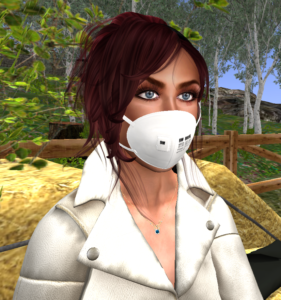
These days wearing a mask to reduce the spread of the COVID-19 disease (caused by the novel SARS-CoV-2 coronavirus) has become second nature. I always understood that coughing was one way viruses were spread. A cough propels water droplets from your lungs into the air and anyone close can inhale them. If your lungs also contain a disease-causing virus, that virus is in the water droplets and if you inhale them, the virus is in you.
A caveat. One virus entity is not enough. One must take a sufficient number of viruses into the lungs, or other suitable host environment, so that the virus can establish itself in sufficient numbers so to cause disease. How many is enough varies with every person.
What was new to me was that just breathing sends tiny water particles, like vapor sort of, drifting into the air. These particles are warm and so they float around for awhile. In a still room, the particles can remain long enough that the next person walking through the room can breath them in, thus acquiring whatever virus might also be riding along in those particles.
We cannot see our breath, except outside on a cold day, when you can see your breath turning into visible vapor. Still, in a warm room, we don’t see our breath floating around or appreciate how it lingers in still air. It occurred to me that an interesting teaching tool could be created in Second Life using the LSL Particles System.
LSL stands for Linden Scripting Language and it is how one adds functionality to objects in SL. The LSL Particles System creates tiny digital objects that behave like RL dust, fireflies, fire, water vapor, etc.
It would be possible to create an avatar animation that produces visible particles as the avatar breathes in and out. With several avatars in a room, you could demonstrate how each avatar moved into the particle fields of the others. This could help to make people more aware of how disease spreads and why mask wearing has become so important.

Another aspect of the diffusion of particles is the rate of air exchange in the room. In a still room, the particles stay around for awhile before settling to the ground (there to wait for someone to pick them up but that’s another issue) or diffusing so much there is no longer a threat of infection. So, a good air conditioning system will exchange the air in a room such that the particles are quickly sucked out of the room and diffused. Filters in the AC system can further filter out bacteria and viruses. So, our particle simulation can include parameters to disperse the particles quickly or slowly and thus demonstrate the utility of efficient air conditioning. Of course, outside the wind blows everything away quickly.
I’m not versed in LSL scripting, so I’m simply tossing out an idea hoping a more creative and skilled person might find this idea useful. If simulations like this already exist, please tell us about it in a comment.
References
- Modeling aerosol transport and virus exposure with numerical simulations in relation to SARS-CoV-2 transmission by inhalation indoors, Ville Vuorinen et al, Safety Science, Volume 130, October 2020.
- Scientific Brief: SARS-CoV-2 and Potential Airborne Transmission, National Center for Immunization and Respiratory Diseases (NCIRD), Division of Viral Diseases, Centers for Disease Control, U.S. Department of Health & Human Services, October 5, 2020.
- LSL Particles System script generator. You input the parameters of the particles you want and this tool generates the LSL script for you.
- Particle Script Creator v1.1.notecard, dazzlesoftware/Secondlife, Stephen Bishop. Detailed instructions for using an in-world interactive script generator.
- Particle Generator – At the Second Life Marketplace there are many tools offered for generating particles. Run a SEARCH for particle generators.
 |
| Visits: 5 |
